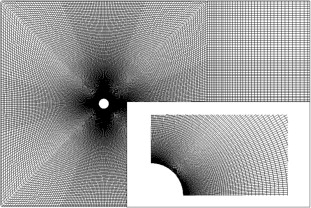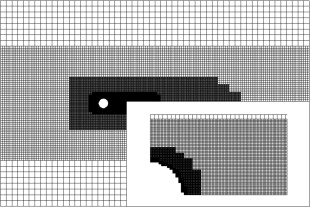M. Meyer, S. Hickel, N.A. Adams (2010)
International Journal of Heat and Fluid Flow 31: 368-377. doi: 10.1016/j.ijheatfluidflow.2010.02.026
The success of Large-Eddy Simulations (LES) of wall-bounded turbulence depends strongly on an accurate representation of the flow near the boundaries. Since in implicit LES the truncation error of the numerical discretization itself functions as SGS model, the order of accuracy of the discretization should be maintained near the boundary. In this paper, we analyze the performance of implicit LES for predicting turbulent flows along complex geometries.
For the representation of wall-boundaries two different approaches are compared: (A) the case of body-fitted grids, and (B) a novel second-order accurate Conservative Immersed Interface Method (CIIM) for representing boundaries of arbitrary shape on Cartesian grids. The need for mapping domain boundaries on the grid raises the question whether a comparable accuracy with body-fitted grids can be achieved. In both (A) and (B) we employ the Adaptive Local Deconvolution Method (ALDM) for implicit LES. The assessment is carried out on the example of the flow over a circular cylinder at Re = 3900. Two simulations with comparable numerical resolution are performed and compared to experimental reference data. Both methods result in similar accuracy for turbulent statistics and mean integral quantities. This demonstrates that ALDM on Cartesian grids is a feasible and efficient approach to simulate turbulent flows on complex domains.


